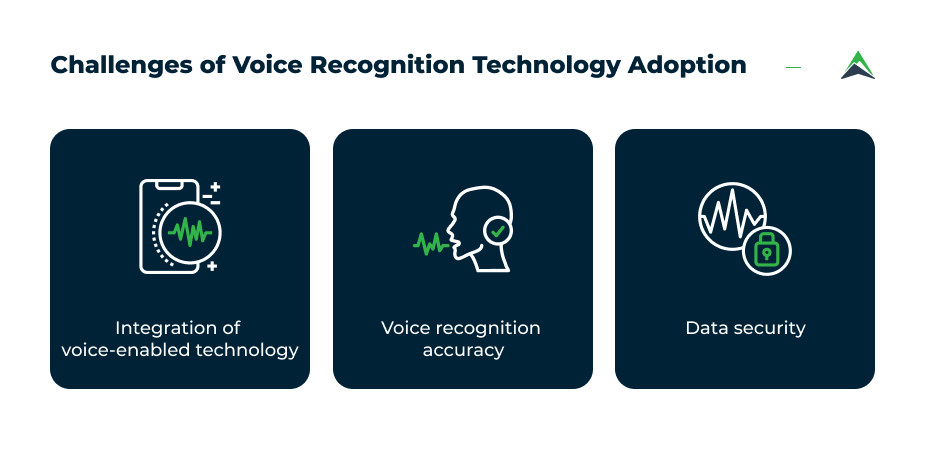The use of AI voice technology for business has the potential to create a huge breakthrough both in company operations and in customer services. Similar to touch screen interfaces revolutionizing the way we, humans, communicate with devices, voice technology solutions are now taking these interactions to an even higher level. Currently, the use cases for voice-enabled solutions extend farther than merely consumer voice-search technology and include smart homes, digital payments, healthcare, and industrial IoT.
Voice tech is immensely popular among Gen Z and the millennials. Yet, despite the growing rate of voice-enabled technology adoption, integrating voice tech is still a challenge for many companies.
In this article, we will uncover the challenges and limitations that stand in the way of the adoption of voice-enabled technology and list the important aspects you should consider when integrating voice tech. Read on to learn more!
Challenges and limitations of voice recognition technology adoption
As easy-to-use and efficient as voice-enabled technologies may appear, it looks like they won’t be entirely replacing graphic user interfaces in the near future.
Admittedly, there can be situations when the use of VUI may be inconvenient or unacceptable, for example:
The need to maintain privacy
Dictating voice commands in public spaces may compromise your privacy or invade the privacy of others. The use of voice interfaces in public places may also be impractical – the background noises and other people talking may render speech recognition impossible.
Individual preferences
Many people find talking to a computer uncomfortable and would rather not humanize machine-to-human interactions. This may have to do with the need to give up long-established habits – some customers may not be willing to embrace the novelty of the VUI.
Real or perceived discomfort
Many people favor written communication over verbal, as it gives them time to think and to pick more accurate words. Users may also be accustomed to quickly switching between apps in graphic interfaces, and verbal control will require mastering entirely new skills. Hence, user acceptance can become a major obstacle, and shouldn’t be taken off counts if you’re looking to invest in voice technology.

Voice-enabled devices and solutions are still likely to thrive in the enterprise, in settings requiring hands-free solutions, or in private settings, for example, in smart homes.
Still, the adoption of voice-enabled technology involves meeting a number of challenges, namely:
Integration of voice-enabled technology
To integrate voice technology into an application, companies need experts with a good working knowledge of machine learning, speech recognition, and computer vision. On top of that, the use of voice technology will require extra computational power and infrastructural resources. Needless to say, all of the above will require expenses.
Voice recognition accuracy
The accuracy of AI-enabled speech and voice recognition still needs improvement. Despite the rapid development of machine learning, voice recognition is still far from having top-notch accuracy.
The work on refining voice technology is underway: the developers are now leveraging deep learning to achieve precise speech recognition in noisy settings. How fast the situation improves depends on a lot of factors, such as the availability of voice data and the development of the machine learning algorithms.
Data security
Privacy and data security concerns are high when it comes to integrating voice recognition technology. Startups using voice technology have to apply advanced encryption mechanisms to safeguard voice data and keep the sensitive personal or business information they transmit entirely protected. This sets the demand for higher security standards, and voice technology security is yet another challenge for implementing voice-enabled solutions.

Things to consider when integrating voice technology
The use of AI voice technology for business enables companies to create memorable user experiences and has great revenue-generating potential. Startups using voice technology may invest in building voice-enabled devices or voice-assistants like Siri.
Alternatively, they may want to integrate voice recognition into an application that already has a pool of loyal users. One way or the other, careful consideration should be taken before plunging into the development of voice tech. Below is a list of things that businesses should take into account before moving forward.
1. Identifying an area for voice tech implementation
The key lies in starting small: for better results, select just one area for implementing voice tech within your organization. Most companies start with using voice assistants to help employees tackle daily tasks. You may begin with already existing enterprise grade voice recognition apps, such as Alexa for business. You may also want to create a custom voice assistant for your company.
Starting with one simple project will help you test-drive voice technologies within your organization. If the outcome is positive, your employees will see the value of voice tech and embrace its further implementation. Choose a task or a process that you can streamline, and evaluate the results.
2. Less is more when it comes to audio content
If you’re going to start with leveraging voice assistants, make sure their responses are clear, concise, and to-the-point. The trick is to make them short, yet informative, so that the users could easily grasp all the necessary information.
Complex sentences and lengthy explanations will only create unnecessary confusions and negate the main purpose of implementing voice technology – fast and simple operations.
3. Go for vendors with context functionality support
As mentioned above, there are many ready-made voice-assistants that you can apply in business. One rule of thumb, though, when choosing a solution for your purposes is making sure your vendor of choice provides context functionality support for your business purposes. This will ensure that the assistant will ultimately direct the conversation towards your desired goals while maintaining its natural flow.

4. Pick the ultimate recognition system for your goals
Voice technology has one sensitive spot: it is still far from being 100% accurate. The recognition system type will dictate just how far your solution is from the absolutely precise voice and speech recognition. At the very least, choose a system with strong Natural Language Understanding (NLU), which you can later enhance with Automatic Semantic Understanding (ASU) modules, if necessary.
There are basically two types of recognition systems: speaker-dependent, recognizing the voice specifics of an individual speaker, and speaker-independent, used mainly in phone assistants. The speaker-independent system is, generally, less accurate, but may still perfectly fit your needs.
5. Define the technology stack
Your next important step will involve choosing the right technology stack for your project. Surely, the technologies you use will depend on the type of the voice recognition software you want to create and on its feature set.
For example, if you’re building a voice assistant, you will want to use technologies like
- Machine Learning: the main technology behind the voice assistant software which recognizes the spoken words and their meaning.
- Biometric voice authentication: this technology helps the assistant recognize the user’s voice and its unique characteristics.
- STT engine: STT stands for “speech-to-text”. This engine converts the words that users say into a written format.
- TTS engine: This type of engine does just the opposite – it converts text into speech. This technology accounts for hands-free communication with a voice app, and endows the assistant with human traits.
- Noise reduction engine: this engine minimizes the noises around the speakers, and helps the voice assistant understand exactly what they are saying.
- Compression engine: this technology compresses the voice data before transfer, for quicker results and with zero data loss.
- Tagging engine: this engine helps understand and deliver what users want. For example, if a user asks: “Do I have any meetings today?” the tagging engine marks this data with a calendar tag.
- Voice User Interface (VUI): this UI is not purely vocal, as it also includes a graphic representation of the voice call out on the smartphone screen.

6. Choose the deployment type
All in all, there are three deployment types: cloud, embedded, and third-party. Each deployment type has its advantages.
Cloud deployment enables all the computations needed for processing voice data to happen in the cloud. This allows developers to build faster and lighter apps. On the downside, cloud apps are dependent on the internet connection, so users may experience interruptions in their performance.
Embedded deployment, on the other hand, has your software using your local device capacities. For example, if a voice app runs on your smartphone, it works fast, with hardly any delays. On the downside, embedded apps may slow down your overall device performance, because they are very resource-intensive.
Third-party deployment involves using the resources of tech giants like Amazon, Google and Microsoft to develop voice apps. Building voice-enabled solutions from scratch is a complex and time-consuming process. Third-party SDKs, APIs and speech libraries help streamline and accelerate voice app development. They are also helpful, if you’re looking for easy ways of how to integrate voice recognition into an app.
Some of the notable libraries and APIs you should know include the following:
- Text-to-Speech API on Google Cloud – the publicly available engine of Google Assistant and Google Maps comes in a variety of versions and in 14 languages.
- Amazon Transcribe – a speech-to-text conversion engine with individual voice recognition and customization capabilities. Currently available only in English and Spanish.
- Siri Shortcuts – an Apple feature allowing developers to make their app’s most frequently used functions available via Siri.
- Azure Speech APIs – this is a combination of four Microsoft services: Custom Speech service, Bing Speech, Translation Speech, and Speaker Recognition.
Most of these services charge usage fees, although they will allow free use during the trial period.
7. Decide on your voice app features
There are a great number of voice apps with basic features which, most of the time, are quite similar. Your task is to come up with a feature set that could offer users something unique and memorable to make them prefer your app over your competitors.
If you’re building an enterprise solution, your app features should be tailored to specific tasks that you need to tackle with your app. The trick is to keep your app future-ready and extendable, in case you will want to add more features.
8. Test your VUI
Testing Voice User Interfaces is different from Graphic UI testing. Human speech has many inaccuracies, pauses and fillers, and VUI testing has to imitate natural utterances to mimic human speech. Moreover, voice experience can change from device to device, which should also be taken into account during the process of voice testing.
Surely, the main principles of testing voice apps are similar to testing traditional applications. Additionally, testers should make sure that the app understands various accents and languages of a request, as well as different ways it can be phrased.
On top of that, the app should know how to deal with requests that fall beyond the scope of its functionality and how to respond, if it doesn’t understand the user’s request. Human responses are unpredictable, so the testing process should include all kinds of positive and negative scenarios.

9. Outline an integration plan
If you plan to further integrate voice technology into your business or products, you need a viable strategy. Starting small is a great idea, but do make sure that the solution you initially build can be expanded to cover more processes, functions or facets of your organization.
It’s also a good idea to build a step-by step plan with the end user in mind. In the end of the day, the quality of user experience will define the success of your voice-enabled solution.
10. Find the right development partner
For most organizations, building voice-enabled solutions or voice-based devices in-house is too expensive and time-consuming. A tech partner with relevant development expertise will accelerate the development process and help you create a solution that will fit your needs.
The price of building your voice app will depend on your partners’ country of residence, but you can always leverage outsourcing to strike a balance between price and quality.
Final thoughts
The future lies in the adoption of voice-enabled technology; moreover, it is already happening faster than you think. In 2018 as much as 84% of the millennials said they were relying on voice assistants for help with daily tasks and schedules. In 2020, the demand for contactless devices amidst the COVID-19 pandemic has boosted the demand for voice technology.
The benefits of voice technology in enterprises are also evident: the ability of voice technology to streamline and accelerate tasks and processes gives organizations an unprecedented competitive edge. Despite many challenges and concerns about accuracy and voice technology security, it looks like voice tech will mature in line with such technologies as deep learning and machine learning.
Looking to integrate voice recognition into an application, or to enhance your enterprise processes with voice tech? At EasternPeak we are ready to give you a helping hand. Contact us now for a free consultation!
Read also:



